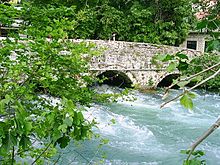Bregava
| Bregava | |
|---|---|

Ćuprija bridge on Bregava river
|
|
| Country | Bosnia and Herzegovina |
| Basin features | |
| Main source | Near town of Stolac |
| River mouth | The Neretva river near town of Čapljina |
| Basin size | The Neretva river |
| Physical characteristics | |
| Length | 20 km (12 mi) |
The Bregava is a sinking river in Bosnia and Herzegovina that passes through the town of Stolac. It is a left tributary of the Neretva river.
The river Bregava and its buildings - bridges, mills and stamping mills over the river - constitutes the backbone of the urban layout of Stolac. It passes through two waterfalls in Stolac, one which is natural and the other artificial, and continue its way through the Bregava canyon leading to Badanj Cave. It is famous for its pure blue colour, like the Neretva river which passes through Mostar. Many natural beaches are spread along the river.
Bregava river also gathers a rich flora biodiversity, wild peppermint, sage, thyme, almond trees and numerous fruit trees (pomegranates, kiwis, plums, grapes...), and fauna living around, butterflies, trout, ducks, numerous diverse birds and water snakes.
Bridges: the most important surviving bridges on the Bregava are Ćuprija (Inat ćuprija), the oldest surviving bridge on the Bregava, assumed from the style of building to date from the medieval period; Podgradska ćuprija, the second oldest bridge in Stolac municipality, believed to have been built in the early 18th century; the bridge in Begovina, most recent of the three stone bridges in Stolac; the Sara Kašiković bridge, built according to its inscription in 1896. This was a privately owned bridge, and had gates to close it off; it is the largest privately owned bridge; the bridge leading to Ada; the small bridge by the Šarić summer residence; and the bridge by the Ali Pasha mosque.
Mills: these are of fairly uniform character, without major differences in the way they were built. In 1664 Evliya Çelebi wrote in his travelogue that there were ten watermills in Dol on the Bregava. In the 18th century Memibegović recounts that the river Bregava runs through Stolac with 180 waterwheels. The oldest known Vakufnama (deed of perpetual endowment) with details of mills was issued for a maintenance endowment dating from 1815, as a result of which the mills can be assumed to date from the early 19th century. They are built of rough-cut stone and are plain and unadorned. Their size is determined by their length, which in turn depends on the number of arches by which the building spans the two banks of the river. The most important of the existing mills are the mill above the Sara Kašiković bridge, the Behmen mill, the Turković mill, and the mills with stamping mills.
...
Wikipedia
